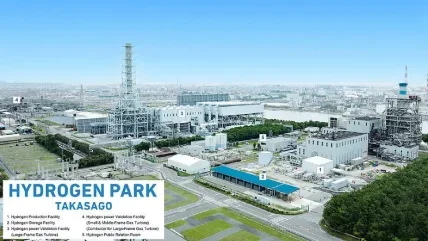
Using hydrogen produced at the Takasago Hydrogen Park, Mitsubishi described this demonstration as the world’s first power generation test on a large frame gas turbine using a fuel mixture of 30% hydrogen while connected to the local power grid and using hydrogen produced and stored on the same site. The Takasago Hydrogen Park makes possible “the integrated validation of hydrogen production, storage, and utilisation (for power generation)”, possible, says Mitsubishi Power.
The demonstration built on a hydrogen project funded by Japan’s New Energy and Industrial Technology Development Organization (NEDO) employing a dry low NOx (DLN) combustor. This demonstration showed that low nitrogen oxide emissions and stable combustion could be achieved with hydrogen co-firing, and that switching fuels from natural gas to a hydrogen blend is possible during partial-load and full-load operation.
In 2024, Mitsubishi Power says it plans to conduct a 100% hydrogen-firing demonstration using a 40 MW H-25 gas turbine installed at Takasago for driving the combustion test facility in the park. In addition, Mitsubishi Power plans to expand the hydrogen storage facility at the site and demonstrate JAC operation with a 50% hydrogen blend.
Ammonia firing
Meanwhile, Centrica Energy and Mitsubishi Power have announced a memorandum of understanding to “explore the development, construction, and operation” of Europe’s first-ever ammonia-fired power generation facility, at Bord Gáis Energy’s Whitegate combined cycle power plant, Cork, Ireland.
The project is being led by Centrica (through its Bord Gáis Energy and Centrica Energy businesses) and Mitsubishi Power Europe, and would become Europe’s inaugural ammonia-fired power generation facility.
Bord Gáis Energy’s facility at Whitegate would serve as a global demonstration site for ammonia-fired power generation technology, providing insight into the feasibility and scalability of low carbon ammonia as a green fuel, with low carbon ammonia being sourced through Centrica Energy’s global trading network.
Following the signing of the MOU, the project team is being established to undertake project feasibility assessments. Assuming successful outcome of this assessment, extensive local stakeholder engagement will commence.
Mitsubishi is also investigating the potential for ammonia as an alternative fuel for coal fired plants and reports that Mitsubishi
Heavy Industries has successfully completed combustion testing of an ammonia single-fuel burner in Japan.
In Singapore, the potential retrofit of Sembcorp’s Sakra combined cycle CHP facility for ammonia burning is under consideration. Sembcorp, IHI and GE Vernova have signed a non-binding memorandum of understanding to jointly explore the possibilities.






